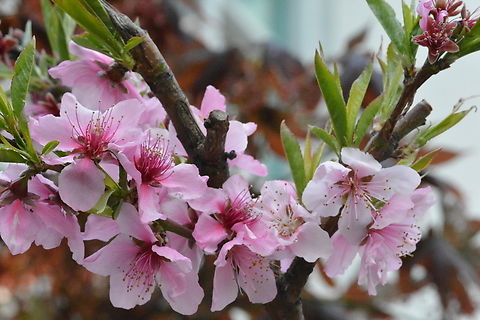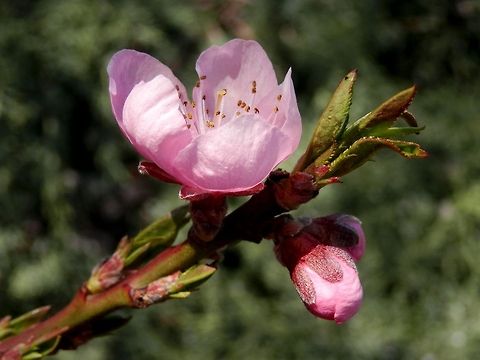
Appearance
"Prunus persica" grows to 4–10 m tall and 6 in. in diameter. The leaves are lanceolate, 7–16 cm long, 2–3 cm broad, pinnately veined. The flowers are produced in early spring before the leaves; they are solitary or paired, 2.5–3 cm diameter, pink, with five petals. The fruit has yellow or whitish flesh, a delicate aroma, and a skin that is either velvety or smooth in different cultivars. The flesh is very delicate and easily bruised in some cultivars, but is fairly firm in some commercial varieties, especially when green. The single, large seed is red-brown, oval shaped, approximately 1.3–2 cm long, and is surrounded by a wood-like husk. Peaches, along with cherries, plums and apricots, are stone fruits. There are various heirloom varieties, including the Indian peach, which arrives in the latter part of the summer.
Naming
The scientific name "persica", along with the word "peach" itself and its cognates in many European languages, derives from an early European belief that peaches were native to Persia. The Ancient Romans referred to the peach as "malum persicum" "Persian apple", later becoming French "pêche", hence the English "peach".Cultivated peaches are divided into clingstones and freestones, depending on whether the flesh sticks to the stone or not; both can have either white or yellow flesh. Peaches with white flesh typically are very sweet with little acidity, while yellow-fleshed peaches typically have an acidic tang coupled with sweetness, though this also varies greatly. Both colours often have some red on their skin. Low-acid white-fleshed peaches are the most popular kinds in China, Japan, and neighbouring Asian countries, while Europeans and North Americans have historically favoured the acidic, yellow-fleshed kinds.
Evolution
Although its botanical name "Prunus persica" refers to Persia from where it came to Europe, genetic studies suggest peaches originated in China, where they have been cultivated since the early days of Chinese culture, circa 2000 BCE. Peaches were mentioned in Chinese writings as far back as the 10th century BCE and were a favoured fruit of kings and emperors. As of late, the history of cultivation of peaches in China has been extensively reviewed citing numerous original manuscripts dating back to 1100 BCE.The peach was brought to India and Western Asia in ancient times. Peach cultivation also went from China, through Persia, and reached Greece by 300 BCE. Alexander the Great introduced the fruit into Europe after he conquered the Persians. Peaches were well known to the Romans in first century AD, and was cultivated widely in Emilia-Romagna. Peach tree is portrayed in the domuswall paintings of the towns destroyed by the Vesuvius eruption of 79 AD, with the oldest artistic representations of peach fruit, discovered so far, are in the two fragments of wall paintings, dated back to the 1st century AD, in Herculaneum, now preserved in the National Archaeological Museum in Naples.
Peach was brought to the Americas by Spanish explorers in the 16th century, and eventually made it to England and France in the 17th century, where it was a prized and expensive treat. The horticulturist George Minifie supposedly brought the first peaches from England to its North American colonies in the early 17th century, planting them at his Estate of Buckland in Virginia. Although Thomas Jefferson had peach trees at Monticello, United States farmers did not begin commercial production until the 19th century in Maryland, Delaware, Georgia and finally Virginia.
In April 2010, an International Consortium, The International Peach Genome Initiative, that include researchers from USA, Italy, Chile, Spain and France announced they had sequenced the peach tree genome.
Cultural
Peaches are not only a popular fruit, but are symbolic in many cultural traditions, such as in art, paintings and folk tales such as Peaches of Immortality.References:
Some text fragments are auto parsed from Wikipedia.